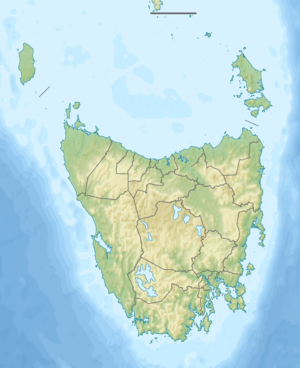Liapootah Power Station
The Liapootah Power Station is a run-of-the-river[2] hydroelectric power station located in the Central Highlands region of Tasmania, Australia. The power station is situated on the Lower River Derwent catchment and is owned and operated by Hydro Tasmania.
| Liapootah Dam | |
|---|---|
 Liapotah Power Station turbines in 2000. | |
 Location of the Paloona Dam in Tasmania | |
| Country | Australia |
| Location | Central Highlands Tasmania |
| Coordinates | 42°18′36″S 146°28′12″E |
| Purpose | Power |
| Status | Operational |
| Opening date | 1960 |
| Owner(s) | Hydro Tasmania |
| Dam and spillways | |
| Type of dam | Gravity dam |
| Impounds | Nive River |
| Height | 40 metres (130 ft) |
| Length | 110 metres (360 ft) |
| Dam volume | 37 thousand cubic metres (1.3×106 cu ft) |
| Spillways | 1 |
| Spillway type | Controlled crest drum gate |
| Spillway capacity | 2,405 cubic metres per second (84,900 cu ft/s) |
| Reservoir | |
| Creates | Lake Liapootah |
| Total capacity | 1,880 megalitres (66×106 cu ft) |
| Catchment area | 1,227 square kilometres (474 sq mi) |
| Surface area | 2.1 hectares (5.2 acres) |
| Liapootah Power Station | |
| Coordinates | 42°18′36″S 146°28′12″E |
| Operator(s) | Hydro Tasmania |
| Commission date | 1960 |
| Type | Run-of-the-river |
| Hydraulic head | 103 metres (338 ft) |
| Turbines | 3 x 29.1 MW (39,000 hp) English Electric Francis-type turbines |
| Installed capacity | 87.3 megawatts (117,100 hp) |
| Capacity factor | 0.9 |
| Annual generation | 440 gigawatt-hours (1,600 TJ) |
| Website hydro | |
| [1] | |
Technical details
Part of the Derwent scheme that comprises eleven hydroelectric power stations, the Liapootah Power Station is the first power station in the lower run-of-river system. The power station is located aboveground below Lake Liapootah. Water from the Derwent below the Tarraleah and Tungatinah Power Station is diverted through a 6.6-kilometre (4.1 mi) concrete lined tunnel. Lake Liapootah is very narrow and is considered a run of river storage. During high inflow events the pond level can threaten the Tarraleah Power Station upstream. The drum gate is designed to lower automatically and maintain a maximum pond level below the flood level of Tarraleah station. Having the drum gate installed maximises the head at Liapootah station. The alternative to this would have been to build the dam at a lower level, thus reducing the available output from Liapootah station.[2][3]
The power station was commissioned in 1960 by the Hydro Electric Corporation (TAS) and the station has three 29.1-megawatt (39,000 hp) English Electric Francis turbines, with a combined generating capacity of 87.3 megawatts (117,100 hp) of electricity.[4] Within the station building, each turbine has a fully embedded spiral casing and water flow is controlled by a spherical rotary main inlet valve and a turbine relief valve designed to prevent spiral casing overpressure. The station output, estimated to be 440 gigawatt-hours (1,600 TJ) annually,[1] is fed to TasNetworks' transmission grid via three banks of 11 kV/220 kV three-phase English Electric generator transformers to the outdoor switchyard.[2]
References
- "Register of Large Dams in Australia" (Excel (requires download)). Dams information. Australian National Committee on Large Dams. 2010. Retrieved 23 June 2015.
- "Liapootah Power Station Fact Sheet: Technical fact sheet" (PDF). Energy: Our power stations. Hydro Tasmania. Archived from the original (PDF) on 24 September 2015. Retrieved 16 January 2015.
- "Derwent: Liapootah Power Station". Energy. Hydro Tasmania. Retrieved 5 July 2015.
- Austral Archaeology Pty Ltd; Terry, Ian (April 2007). "Liapootah Power Station—Conservation Management Plan" (PDF). Retrieved 1 February 2012.